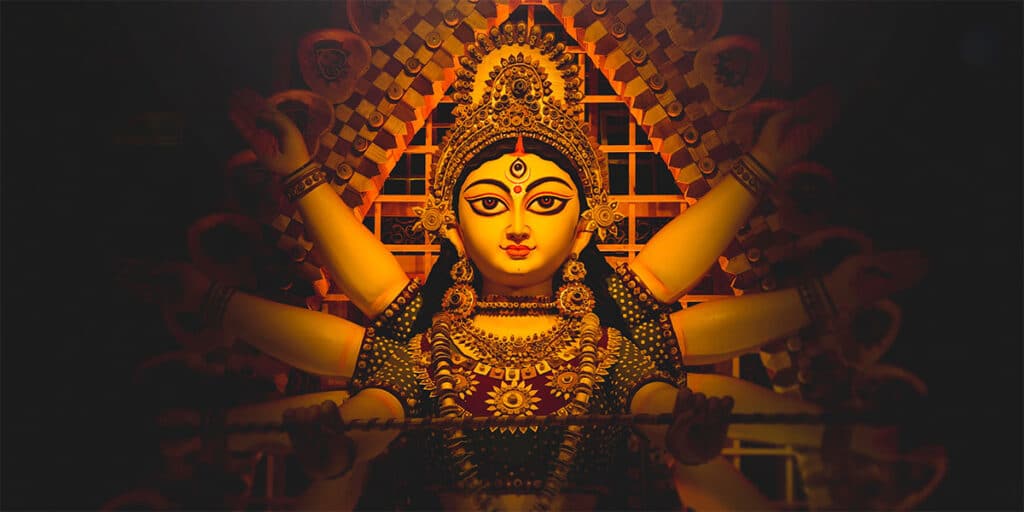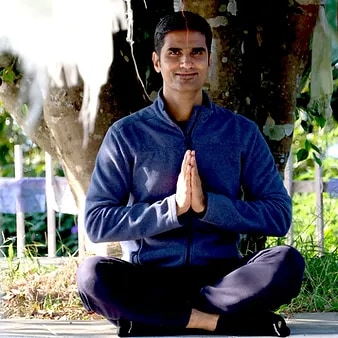Navratri Sadhana: A Sacred Journey of Self-Discovery and Spiritual Growth
by Hardik Mehta

Navratri, which translates to “Nine Nights,” stands as one of India’s most significant and cherished festivals. It symbolizes a period of intense devotion, spiritual awakening, and inner cleansing, during which worshipers honour the nine manifestations of Goddess Durga. Beyond the external festivities, Navratri is a time to delve into sadhana (spiritual practice), allowing individuals to connect with their inner self and the divine.
In this blog, we will explore the essence of Navratri Sadhana, its significance, how to perform it, and its benefits for holistic well-being. Navratri Sadhana isn’t just about religious rituals but is a path that encourages mental, emotional, and spiritual evolution. Whether you are a seasoned practitioner or someone new to yoga and spirituality, this journey can bring transformative changes to your life.
The Significance of Navratri Sadhana
Navratri Sadhana carries profound spiritual meaning, as it centres on the reverence of Goddess Durga, who represents the divine manifestation of feminine power, also known as Shakti. During these nine days, different manifestations of Durga are worshiped, each representing a unique aspect of life and spirituality:
Shailaputri – The goddess of nature and purity.
Brahmacharini – Represents pure devotion and the pursuit of penance. She represents unwavering dedication and deep spiritual practice.
Chandraghanta – Representing bravery and the spirit of courage.
Kushmanda – The creator of the universe.
Skandamata – The divine mother of Lord Skanda, embodies the nurturing essence of motherhood.
Katyayani – The goddess of war and strength.
Kalaratri – The formidable vanquisher of ignorance and darkness.
Mahagauri – The symbol of purity and peace.
Siddhidatri – The giver of supernatural powers (siddhis).
Each of these forms signifies a step towards achieving higher consciousness. Navratri is a perfect time for self-reflection, cultivating discipline, and harmonizing with the natural flow of the universe. By observing Navratri Sadhana, you harmonize your energies with that of the cosmic energy (Shakti), creating a pathway for personal and spiritual growth.
Preparing for Navratri Sadhana
Navratri Sadhana begins with preparing the body and mind to receive the divine energy that the nine nights offer. Here are a few key practices to prepare for this sacred journey:
Cleansing the Mind: Meditation and pranayama (breath control) are essential to calming the mind and focusing on your sadhana. As Navratri approaches, take time to meditate regularly, focusing on positive thoughts, gratitude, and forgiveness. This practice will purify your mind and prepare it to receive higher energy.
Purifying the Body: Fasting or consuming sattvic (pure) food is a common practice during Navratri. Avoiding tamasic (low vibrational) foods like meat, alcohol, and processed foods can cleanse your body, allowing energy to flow freely and making it easier to connect with the divine.
Setting an Intention: Before starting your Navratri Sadhana, set a clear intention for what you wish to achieve during these nine days. This could be spiritual growth, inner peace, or even specific life goals. Writing down your intention in a journal can help reinforce your commitment to the sadhana.
Creating a Sacred Space: Designate a peaceful area in your home where you can practice your sadhana. Decorate it with images of Goddess Durga, candles, and flowers to create an environment of tranquillity and devotion.
Steps to Perform Navratri Sadhana
Each day of Navratri represents a different form of Goddess Durga, and your sadhana should be aligned with these energies. Here is a simple guide on how to perform Navratri Sadhana:
- Morning Meditation
Start your day with meditation focused on the form of the goddess for that particular day. Visualize her energy entering your body, cleansing it of negativity and filling you with strength, courage, and peace.
- Chanting Mantras
Mantras are a powerful way to connect with divine energy. Each goddess has a specific mantra associated with her, which you can chant during your meditation or throughout the day. For example, for Goddess Shailaputri, you can chant:
“Om Devi Shailaputryai Namah”
Chanting mantras elevates your consciousness and helps you stay focused on your spiritual goals.
- Pranayama
Incorporating pranayama, or breathwork, is crucial in Navratri Sadhana. It not only enhances your physical well-being but also calms your mind and prepares it for higher spiritual practices. Practices like Nadi Shodhana (alternate nostril breathing) and Kapalabhati (skull shining breath) can help purify your energy channels, making you more receptive to divine vibrations.
- Daily Worship
Performing puja (ritual worship) is an integral part of Navratri Sadhana. Offer flowers, light diyas (oil lamps), and offer bhog (sacred food) to the goddess. During the puja, recite the Durga Chalisa or Devi Stotra to invoke her blessings.
- Evening Reflection
As the evening approaches, set aside a moment to reflect on the sadhana you’ve practiced throughout the day. Journaling your experiences, feelings, and thoughts can help you track your spiritual progress and stay aligned with your intentions.
Fasting During Navratri Sadhana
Fasting is a key element of Navratri Sadhana and is believed to purify both the body and mind. It helps in controlling desires and discipline. There are different types of fasting, ranging from complete fasts to consuming only fruits and water. The choice of fast depends on your physical and mental endurance. However, it is essential to stay hydrated and consume sattvic foods like fruits, vegetables, and dairy products to maintain energy levels.
The Spiritual Benefits of Navratri Sadhana
Navratri Sadhana offers profound spiritual and emotional benefits. Some of the key benefits include:
Inner Strength and Clarity: By connecting with the divine feminine energy, you gain strength and clarity to overcome challenges and obstacles in life.
Emotional Balance: The discipline and mindfulness practiced during sadhana bring emotional balance, reducing stress and anxiety.
Deep Inner Peace: Regular meditation and prayer during Navratri help calm the mind, leading to a deep sense of inner peace and contentment.
Connection with the Divine: Navratri Sadhana fosters a deeper connection with the divine, allowing you to experience a heightened sense of spiritual awareness and consciousness.
Manifestation of Desires: By aligning your energies with the cosmic Shakti, you enhance your ability to manifest your desires and intentions.
Physical Detoxification: Fasting during Navratri helps detoxify the body, improving overall health and vitality.
Navratri Sadhana is not just a religious practice but a profound spiritual journey that empowers individuals to connect with the divine feminine energy within. By dedicating these nine days to self-purification, devotion, and mindfulness, you open the door to tremendous inner transformation, peace, and joy. Whether you are seeking spiritual growth, emotional balance, or physical detoxification, Navratri Sadhana is a beautiful and powerful path to explore.
At Sayujya Yoga, we honour the traditions and philosophies of yoga, offering a deep blend of ancient wisdom with contemporary practice. If you wish to explore deeper aspects of yoga and spirituality, we offer 200 Hours Teacher Training Courses (TTC) and short courses that can help you embark on a journey of self-discovery and transformation. Located in the heart of Mumbai, Sayujya Yoga is one of the best yoga centres, providing holistic training and spiritual guidance for seekers at all levels.
About the Author

Hardik Mehta
Hardik is an E-RYT 500 & YACEP (Yoga Alliance Continuing Education Provider), Yoga Alliance, USA. He has been practicing yoga for the last 9 years. Prior to finding his true calling in Yoga, he was working with various corporates for 12 years in the Retail and eCommerce sector.
